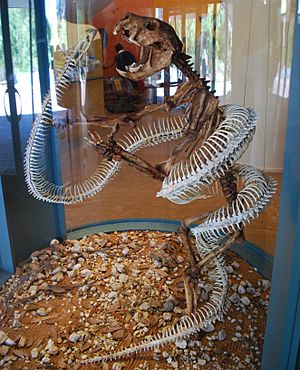Wonambi facts for kids
Quick facts for kids Wonambi |
|
|---|---|
 |
|
| Wonambi naracoortensis and Thylacoleo | |
| Scientific classification |
|
| Kingdom: | Animalia |
| Phylum: | Chordata |
| Class: | Reptilia |
| Order: | Squamata |
| Suborder: | Serpentes |
| Family: | †Madtsoiidae |
| Genus: | †Wonambi |
| Type species | |
| Wonambi naracoortensis Smith, 1976
|
|
| Species | |
|
†Wonambi barriei Scanlon, 2000 |
|
Wonambi was a type of giant snake that lived in Australia a very long time ago. These snakes are now extinct, meaning they no longer exist. They lived from the late Neogene period to the late Quaternary period. This covers a huge span of time, from about 23 million years ago until about 12,000 years ago.
Wonambi snakes were constrictors. This means they would squeeze their prey to catch it, much like some modern snakes do. They were not related to the pythons we see in Australia today.
Contents
Types of Wonambi Snakes
There are two main types, or species, of Wonambi that scientists know about.
Wonambi naracoortensis
This is the most famous type of Wonambi. It was a very large snake, growing to be about five to six meters long. That's longer than a small car! Wonambi naracoortensis was part of the "megafauna" of Australia during the Pleistocene Ice Age. Megafauna refers to the very large animals that lived during that time.
Wonambi barriei
The other known species is Wonambi barriei. This snake lived even earlier, during the Miocene period. Fossils of Wonambi barriei have been found in a place called Riversleigh.
What Did Wonambi Look Like?
Wonambi snakes were not venomous, so they didn't use poison to catch their food. Instead, they were constrictors. They would likely hide and wait for their prey, then ambush it. Once they caught an animal, they would squeeze it tightly until it couldn't breathe.
These snakes had a relatively small head compared to their body size. This meant they could only eat prey that wasn't too big.
Where Did the Name Wonambi Come From?
The first fossils of Wonambi naracoortensis were found in Naracoorte, South Australia. This was the first time scientists had found an extinct snake in Australia.
The name Wonambi comes from the local Aboriginal people. They have stories about a giant serpent from the Dreamtime, which is their spiritual time of creation. This serpent is often called the Rainbow Serpent. It is believed to have created many important features of the land. The Wagyl, a similar serpent from the Noongar people in Western Australia, is thought to be connected to the Wonambi stories.
Another similar giant snake, called Yurlunggur, was found in Queensland and the Northern Territory. It could be even bigger, up to 9 meters long, with a body about 30 centimeters wide!
The family of snakes that Wonambi belongs to, called Madtsoiidae, died out in most parts of the world about 55 million years ago. But in Australia, new species of these snakes continued to evolve. Wonambi snakes were among the last of this family to exist anywhere. They became extinct within the last 50,000 years.
How Wonambi Lived
Wonambi naracoortensis lived during the Pleistocene Ice Age. They often lived near waterholes, especially in sunny spots. They would wait there to ambush animals like kangaroos and wallabies that came to drink.
Because these waterholes were dangerous places with large predators, Aboriginal culture had rules about them. Children were not allowed to play at these spots alone. They could only visit if an adult was with them. In Western Australia, places linked to the Wagyl serpent are often considered sacred sites by the Noongar people.
Some scientists, like Tim Flannery, suggest that Wonambi and other large Australian animals became extinct partly because of human activities. Aboriginal Australians used methods like hunting and "firestick farming." Firestick farming is a way of using controlled fires to manage the land. These activities might have changed the environment and affected the animals.
Images for kids
-
Wonambi naracoortensis and Thylacoleo


